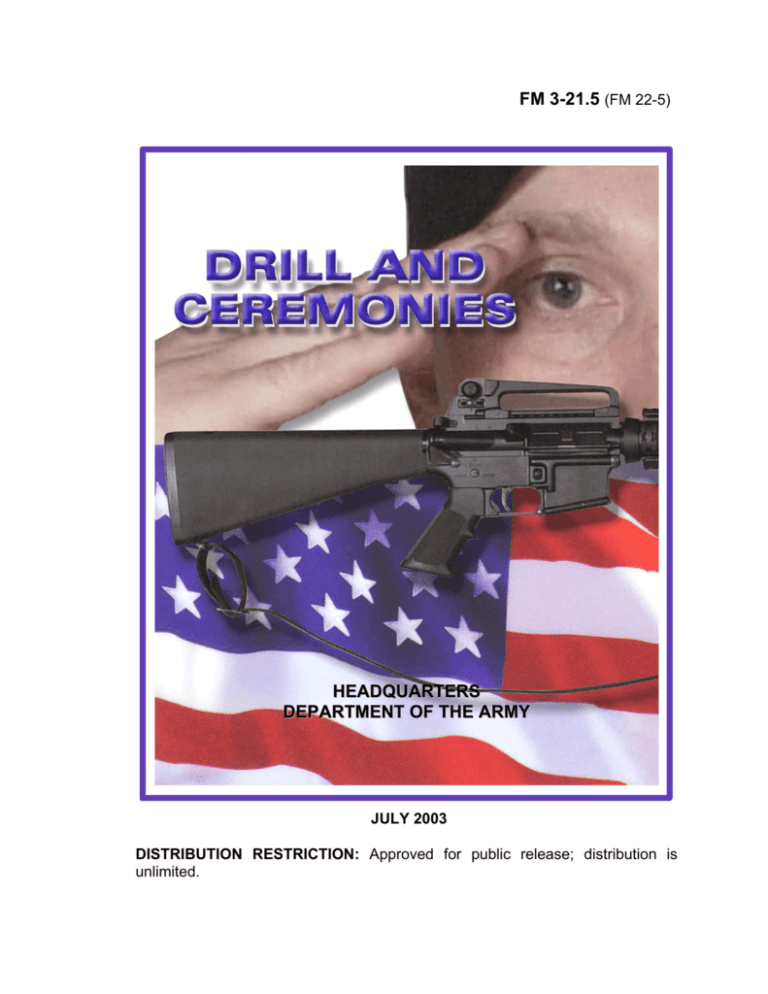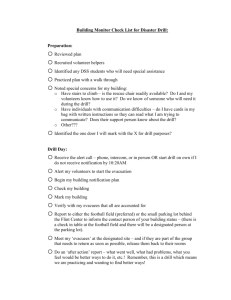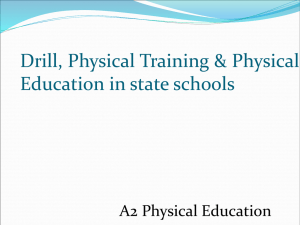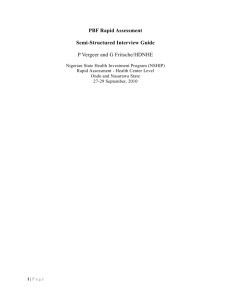FM 3-21.5 (FM 22-5) - Monroe Township Public Schools
advertisement

FM 3-21.5 (FM 22-5) HEADQUARTERS DEPARTMENT OF THE ARMY JULY 2003 DISTRIBUTION RESTRICTION: Approved for public release; distribution is unlimited. *FM 3-21.5(FM 22-5) FIELD MANUAL No. 3-21.5 HEADQUARTERS DEPARTMENT OF THE ARMY WASHINGTON, DC, 7 July 2003 DRILL AND CEREMONIES CONTENTS Page PREFACE........................................................................................................................ vii Part One. DRILL CHAPTER 1. INTRODUCTION 1-1. History ................................................................................... 1-1 1-2. Military Music ....................................................................... 1-2 CHAPTER Section 2. DRILL INSTRUCTIONS I. Instructional Methods ........................................................................ 2-1 2-1. Explanation ............................................................................ 2-1 2-2. Demonstration........................................................................ 2-2 2-3. Practice................................................................................... 2-6 II. Instructional Techniques.................................................................... 2-6 2-4. Formations ............................................................................. 2-6 2-5. Instructors .............................................................................. 2-8 2-6. Cadence Counting.................................................................. 2-8 Section CHAPTER Section Section 3. COMMANDS AND THE COMMAND VOICE I. Commands ......................................................................................... 3-1 3-1. Rules ...................................................................................... 3-1 3-2. Two-Part Commands ............................................................. 3-1 3-3. Combined Commands............................................................ 3-2 3-4. Supplementary Commands .................................................... 3-2 3-5. Directives ............................................................................... 3-3 II. The Command Voice ......................................................................... 3-4 3-6. Voice Control......................................................................... 3-4 3-7. Distinctiveness ....................................................................... 3-4 3-8. Inflection ................................................................................ 3-4 3-9. Cadence.................................................................................. 3-5 DISTRIBUTION RESTRICTION: Approved for public release; distribution is unlimited. __________________________ *This publication supersedes FM 22-5, dated 8 December 1986. i FM 3-21.5 Page CHAPTER Section Section CHAPTER Section Section CHAPTER Section ii 4. INDIVIDUAL DRILL I. Stationary Movements ....................................................................... 4-1 4-1. Position of Attention .............................................................. 4-1 4-2. Rest Positions at the Halt ....................................................... 4-2 4-3. Facing at the Halt ................................................................... 4-4 4-4. Hand Salute............................................................................ 4-6 II. Steps and Marching ........................................................................... 4-7 4-5. Basic Marching Information .................................................. 4-7 4-6. The 30-Inch Step.................................................................... 4-8 4-7. Change Step ........................................................................... 4-8 4-8. Marching to the Rear ............................................................. 4-8 4-9. Rest Movement, 30-Inch Step ............................................... 4-9 4-10. The 15-Inch Step, Forward/Half Step.................................... 4-9 4-11. Marching in Place ................................................................ 4-10 4-12. The 15-Inch Step, Right/Left ............................................... 4-10 4-13. The 15-Inch Step, Backward ............................................... 4-10 4-14. The 30-Inch Step, Double Time........................................... 4-11 4-15. Facing in Marching .............................................................. 4-11 5. INDIVIDUAL DRILL WITH WEAPONS I. Manual of Arms—M16-Series Rifle ................................................. 5-1 5-1. Basic Procedures.................................................................... 5-2 5-2. Order Arms ............................................................................ 5-2 5-3. Rest Position .......................................................................... 5-3 5-4. Port Arms ............................................................................... 5-4 5-5. Present Arms.......................................................................... 5-5 5-6. Inspection Arms ..................................................................... 5-7 5-7. Right Shoulder Arms ............................................................. 5-8 5-8. Left Shoulder Arms.............................................................. 5-10 5-9. Changing Positions .............................................................. 5-11 5-10. Fix and Unfix Bayonets ....................................................... 5-12 II. Sling Arms—M16-Series Rifle ....................................................... 5-12 5-11. Basic Procedures.................................................................. 5-12 5-12. Sling Arms ........................................................................... 5-13 5-13. Salute at Sling Arms ............................................................ 5-15 5-14. Port Arms from Sling Arms ................................................. 5-16 5-15. Inspection Arms from Sling Arms....................................... 5-17 6. SQUAD DRILL I. Formations and Movements............................................................... 6-1 6-1. Basic Information................................................................... 6-1 6-2. Forming the Squad................................................................. 6-1 6-3. Counting Off .......................................................................... 6-3 6-4. Changing Interval While in Line ........................................... 6-3 FM 3-21.5 Page Section CHAPTER Section Section Section CHAPTER Section Section 6-5. Aligning the Squad ................................................................ 6-4 6-6. Marching the Squad ............................................................... 6-6 6-7. Changing the Direction of a Column ..................................... 6-7 6-8. Marching to the Flank............................................................ 6-7 6-9. Forming a Column of Twos and Re-forming ........................ 6-8 6-10. Dismissing the Squad............................................................. 6-8 II. Stack and Take Arms (M16-Series Rifle).......................................... 6-8 6-11. Prepare Slings ........................................................................ 6-9 6-12. Stack Arms............................................................................. 6-9 6-13. Take Arms............................................................................ 6-10 7. PLATOON DRILL I. Formations ......................................................................................... 7-1 7-1. Basic Information................................................................... 7-1 7-2. Forming the Platoon............................................................... 7-4 7-3. Breaking Ranks...................................................................... 7-5 7-4. Counting Off .......................................................................... 7-5 7-5. Changing Interval .................................................................. 7-5 7-6. Aligning the Platoon .............................................................. 7-6 7-7. Opening and Closing Ranks .................................................. 7-7 7-8. Resting the Platoon ................................................................ 7-8 7-9. Dismissing the Platoon .......................................................... 7-8 II. Movements......................................................................................... 7-8 7-10. Eyes Right.............................................................................. 7-9 7-11. Changing the Direction of a Column ..................................... 7-9 7-12. Marching to the Flanks ........................................................ 7-12 7-13. Forming a File and Re-forming ........................................... 7-12 7-14. Forming a Column of Twos and Re-forming ...................... 7-13 III. Inspections ....................................................................................... 7-14 7-15. Basic Information................................................................. 7-14 7-16. In-Ranks Inspection ............................................................. 7-15 7-17. Squad Leaders’ Inspection................................................... 7-15 7-18. Platoon Sergeant’s/Platoon Leader’s Inspection ................. 7-16 7-19. In-Quarters (Stand By) Inspection....................................... 7-17 8. COMPANY DRILL I. Procedures and Personnel .................................................................. 8-1 8-1. Basic Information................................................................... 8-1 8-2. Posts for Key Personnel ......................................................... 8-2 II. Formations and Movements............................................................... 8-6 8-3. Basic Information................................................................... 8-6 8-4. Changing Interval .................................................................. 8-8 8-5. Changing Distance ................................................................. 8-9 8-6. Aligning the Company......................................................... 8-10 iii FM 3-21.5 Page 8-7. 8-8. 8-9. 8-10. 8-11. 8-12. 8-13. 8-14. 8-15. 8-16. Section CHAPTER Opening and Closing Ranks ................................................ 8-10 Changing the Direction of March of a Column ................... 8-11 Closing the Distance Between Platoons .............................. 8-12 Correcting the Distance Between Platoons.......................... 8-12 Forming a Column of Twos and Re-forming ...................... 8-13 Forming a Company Mass ................................................... 8-13 Aligning a Company in Mass .............................................. 8-14 Changing the Direction of March of a Mass Formation...... 8-14 Forming a Column from a Company Mass.......................... 8-15 Forming a Company in Column with Platoons in Line and Re-forming........................................................ 8-15 8-17. Dismissing the Company ..................................................... 8-16 III. Inspections ....................................................................................... 8-16 8-18. Basic Information................................................................. 8-16 8-19. In-Ranks Inspection (Line Formations)............................... 8-19 8-20. In-Quarters Inspection (Stand By)....................................... 8-21 9. BATTALION AND BRIGADE DRILL 9-1. Battalion Formations.............................................................. 9-1 9-2. Brigade Formations................................................................ 9-6 Part Two. CEREMONIES CHAPTER 10. REVIEWS 10-1. History ................................................................................. 10-1 10-2. Types of Reviews................................................................. 10-3 10-3. Sequence of Events and Individual Actions ........................ 10-8 10-4. Review with Decorations, Awards, and Individual Retirement (Sequence of Events) ..................... 10-20 10-5. Review with Change of Command, Activation, or Deactivation (Sequence of Events) ............................... 10-21 10-6. Review with Retreat (Sequence of Events) ....................... 10-25 10-7. Special Review .................................................................. 10-26 CHAPTER 11. PARADES 11-1. History ................................................................................. 11-1 11-2. Preparation ........................................................................... 11-2 11-3. Ceremonial Battalion Parade ............................................... 11-2 11-4. Ceremonial Brigade Parade ................................................. 11-5 11-5. Street Parades....................................................................... 11-6 iv FM 3-21.5 Page CHAPTER 12. HONOR GUARDS 12-1. Basic Information................................................................. 12-1 12-2. Sequence of Events and Individual Actions ........................ 12-1 12-3. Honor Cordon Ceremonies .................................................. 12-3 CHAPTER 13. RETREATS AND REVEILLES 13-1. Retreat History ..................................................................... 13-1 13-2. Retreat Sequence of Events ................................................. 13-1 13-3. Command Retreat History ................................................... 13-1 13-4. Command Retreat Sequence of Events................................ 13-2 13-5. Reveille History ................................................................... 13-2 13-6. Reveille Sequence of Events................................................ 13-2 13-7. Command Reveille History.................................................. 13-3 13-8. Command Reveille Sequence of Events .............................. 13-3 CHAPTER 14. FUNERALS 14-1. History ................................................................................. 14-1 14-2. Types of Funerals................................................................. 14-1 14-3. Individual Responsibilities .................................................. 14-2 14-4. Personnel Conduct ............................................................... 14-3 14-5. Funeral with Chapel Service (Full Military Honors)........... 14-3 14-6. Two-Man Honor Detail ....................................................... 14-8 14-7. Graveside Service .............................................................. 14-10 14-8. Cremated Remains ............................................................. 14-11 14-9. Ceremony Before Shipment of Remains ........................... 14-13 14-10. Cannon Salute .................................................................... 14-13 14-11. Funerals Off Post ............................................................... 14-13 14-12. Participation of Aviation.................................................... 14-14 14-13. Participation of Fraternal or Patriotic Organizations......... 14-14 14-14. Duties of the Chaplain ....................................................... 14-14 14-15. Preliminary Arrangements ................................................. 14-14 14-16. Floral Tributes.................................................................... 14-15 14-17. Rules for Ceremonial Firing .............................................. 14-15 CHAPTER 15. COLORS 15-1. History ................................................................................. 15-1 15-2. The Color and Colors........................................................... 15-2 15-3. Salutes .................................................................................. 15-3 15-4. Color Guard ......................................................................... 15-3 15-5. Receiving or Dismissing the Colors by the Color Guard .............................................................. 15-4 15-6. Casing and Uncasing the Colors .......................................... 15-4 15-7. Receiving or Dismissing the Colors by Color Company............................................................... 15-5 v FM 3-21.5 Page 15-8. 15-9. 15-10. 15-11. 15-12. 15-13. 15-14. 15-15. 15-16. Posting and Retiring the Colors ........................................... 15-6 Movement of Three-Man Color Guard to the Rear ............. 15-8 Movement of Four-Man Color Guard to the Rear ............... 15-9 Movement of Five-Man Color Guard to the Rear ............. 15-10 Movement of Six-Man Color Guard to the Rear ............... 15-12 Position of the Colors at the Order .................................... 15-13 Position of the Colors at the Carry..................................... 15-14 Position of the Colors at Parade Rest................................. 15-16 Position of the Organizational Color at Color Salute ................................................................... 15-16 CHAPTER 16. SALUTE BATTERY 16-1. Preparation ........................................................................... 16-1 16-2. Sequence of Events and Individual Actions ........................ 16-2 CHAPTER 17. CIVILIAN PARTICIPATION IN MILITARY CEREMONIES 17-1. History ................................................................................. 17-1 17-2. Types of Ceremonies ........................................................... 17-1 APPENDIX A. SALUTING...................................................................................... A-1 APPENDIX B. MANUAL OF ARMS—M4-SERIES CARBINE..........................B-1 APPENDIX C. MANUAL OF ARMS—M14 RIFLE .............................................C-1 APPENDIX D. MANUAL OF ARMS—M1903 OR M1917 RIFLE .................... D-1 APPENDIX E. MANUAL OF ARMS—SPECIALTY WEAPONS ......................E-1 APPENDIX F. MANUAL OF ARMS—SABER AND SWORD ........................... F-1 APPENDIX G. SYMBOLS ....................................................................................... G-1 APPENDIX H. MANUAL OF THE GUIDON ....................................................... H-1 APPENDIX I. CEREMONY CHECKLIST ............................................................I-1 APPENDIX J. MOUNTED DRILL ..........................................................................J-1 APPENDIX K. FLAGS AND COLORS.................................................................. K-1 GLOSSARY........................................................................................................ Glossary-1 REFERENCES............................................................................................... References-1 INDEX...................................................................................................................... Index-1 vi FM 3-21.5(FM 22-5) PREFACE This field manual provides guidance for Armywide uniformity in the conduct of drill and ceremonies. It includes methods of instructing drill, teaching techniques, individual and unit drill, manual of arms for infantry weapons, and various other aspects of basic drill instruction. This manual is designed for use by soldiers of all military occupational skills, to include the new soldier in the initial entry training environment. Since all situations or eventualities pertaining to drill and ceremonies cannot be foreseen, commanders may find it necessary to adjust the procedures to local conditions. However, with the view toward maintaining consistency throughout the Army, the procedures prescribed herein should be followed as closely as possible. Personnel preparing to give drill instruction must be thoroughly familiar with Chapters 3 through 7 before attempting to teach material in Chapters 8 and 9. For ease in distinguishing a preparatory command from a command of execution, the commands of execution appear in BOLD CAP letters and preparatory commands appear in Bold Italic letters. Reference to positions and movements appear in Italics. AR 670-1 should be used as a reference for the proper wearing of uniforms and insignia. The proponent of this publication is the U.S. Army Infantry School. Send comments and recommendations to doctrine@benning.army.mil or on DA Form 2028 directly to Commandant, U.S. Army Infantry School, ATTN: ATSH-ATD, Fort Benning, Georgia 31905-5410. Unless this publication states otherwise, masculine nouns and pronouns do not refer exclusively to men. vii FM 3-21.5(FM 22-5) PART ONE DRILL “Gentlemen: you have now reached the last point. If anyone of you doesn’t mean business let him say so now. An hour from now will be too late to back out. Once in, you’ve got to see it through. You’ve got to perform without flinching whatever duty is assigned you, regardless of the difficulty or the danger attending it. If it is garrison duty, you must attend to it. If it is meeting fever, you must be willing. If it is the closest kind of fighting, anxious for it. You must know how to ride, how to shoot, how to live in the open. Absolute obedience to every command is your first lesson. No matter what comes you mustn’t squeal. Think it over - all of you. If any man wishes to withdraw he will be gladly excused, for others are ready to take his place.” Theodore Roosevelt, Remarks to Recruits, 1898 CHAPTER 1 INTRODUCTION The purpose of drill is to enable a commander or noncommissioned officer to move his unit from one place to another in an orderly manner; to aid in disciplinary training by instilling habits of precision and response to the leader’s orders; and to provide for the development of all soldiers in the practice of commanding troops. 1-1. HISTORY Military history reveals that armies throughout the world participated in some form of drill. The primary value of drill, historically, is to prepare troops for battle. For the most part, the drill procedures practiced are identical to the tactical maneuvers employed on the battlefield. Drill enables commanders to quickly move their forces from one point to another, mass their forces into a battle formation that affords maximum firepower, and maneuver those forces as the situation develops. a. In 1775, when this country was striving for independence and existence, the nation’s leaders were confronted with the problem of not only establishing a government but also of organizing an army that was already engaged in war. From the “shot heard around the world,” on 19 April 1775, until Valley Forge in 1778, Revolutionary forces were little more than a group of civilians fighting Indian-style against well-trained, highly disciplined British Redcoats. For three years, General George Washington’s troops had endured many hardships—lack of funds, rations, clothing, and equipment. In addition, they had suffered loss after loss to the superior British forces. These hardships and losses mostly stemmed from the lack of a military atmosphere in country. Thus, an army was created with little or no organization, control, discipline, or teamwork. b. Recognizing the crisis, General Washington, through Benjamin Franklin, the American Ambassador to France, enlisted the aid of a Prussian officer, Baron Friedrich 1-1 FM 3-21.5 von Steuben. Upon his arrival at Valley Forge on 23 February 1778, von Steuben, a former staff officer with Frederick the Great, met an army of several thousand half-starved, wretched men in rags. He commented that a European army could not be kept together in such a state. To correct the conditions that prevailed, he set to work immediately and wrote drill movements and regulations at night and taught them the following day to a model company of 120 men selected from the line. c. Discipline became a part of military life for these selected individuals as they learned to respond to command without hesitation. This new discipline instilled in the individual a sense of alertness, urgency, and attention to detail. Confidence in himself and his weapon grew as each man perfected the fifteen 1-second movements required to load and fire his musket. As the Americans mastered the art of drill, they began to work as a team and to develop a sense of pride in themselves and in their unit. d. Watching this model company drill, observers were amazed to see how quickly and orderly the troops could be massed and maneuvered into different battle formations. Officers observed that organization, chain of command, and control were improved as each man had a specific place and task within the formation. Later, the members of the model company were distributed throughout the Army to teach drill. Through drill, they improved the overall effectiveness and efficiency of the Army. e. To ensure continuity and uniformity, von Steuben, by then a major general and the Army Inspector General, wrote the first Army field manual in 1779, The Regulations for the Order and Discipline of the Troops of the United States, commonly referred to as the Blue Book. The drill procedures initiated at Valley Forge were not changed for 85 years, until the American Civil War, and many of the drill terms and procedures are still in effect today. f. Drill commands are about the same as at the time of the War of 1812, except that then the officers and noncommissioned officers began them by saying, “Take care to face to the right, right, face.” Also, during the American revolutionary period, troops marched at a cadence of 76 steps a minute instead of the current cadence of 120 steps. Then units performed precise movement on the battlefield, and the army that could perform them best was often able to get behind the enemy, or on his flank, and thus beat him. Speed spoiled the winning exactness. Also, firearms did not shoot far or accurately in 1776, so troop formations could take more time to approach the enemy. g. As armament and weaponry improved, drill had to adapt to new tactical concepts. Although the procedures taught in drill today are not normally employed on the battlefield, the objectives accomplished by drill—professionalism, teamwork, confidence, pride, alertness, attention to detail, esprit de corps, and discipline—are just as important to the modern Army as they were to the Continental Army. 1-2. MILITARY MUSIC The earliest surviving pictorial, sculptured, and written records show musical or quasimusical instruments employed in connection with military activity for signaling during encampments, parades, and combat. Because the sounds were produced in the open air, the instruments tended to be brass and percussion types. Oriental, Egyptian, Greek, Roman, and American Indian chronicles and pictorial remains show trumpets and drums of many varieties allied to soldiers and battles. 1-2 FM 3-21.5 a. Bugle Calls. Bugle calls are used in U.S. military service as the result of the Contintental Army’s contact with the soldiers and armies from Europe during the revolutionary period. After the American Revolution, many of the French (and English) bugle calls and drum beats were adopted by the United States Army. b. Attention. This is taken from the British “Alarm,” at which call the troops turned out under arms. c. Adjutant’s Call. The adjutant’s call indicates that the adjutant is about to form the guard, battalion, or regiment. d. To the Color. The old cavalry call, “To the Standard,” in use from about 1835, was replaced by the present call of “To the Color.” e. National Anthem. “The Star Spangled Banner” officially became the National Anthem by law on 3 March 1931, in Title 36, United States Code 170. f. Sound Off. The band, in place, plays “Sound Off’ (three chords). It then moves forward and, changing direction while playing a stirring march, troops the line and marches past the soldiers in formation, then returns to its post. Upon halting, the band again plays three chords. g. Retreat. Retreat is the ceremony that pays honors to the national flag when it is lowered in the evening. h. Official Army Song. The official Army song, “The Army Goes Rolling Along,” was formally dedicated by the Secretary of the Army on Veterans Day, 11 November 1956, and officially announced on 12 December 1957 (AR 220-90). In addition to standing while the National Anthem is played, Army personnel stand at attention whenever the official song is played. Although there is no Department of the Army directive in this regard, commanders, other officers, and other personnel can encourage the tribute to the Army by standing at attention when the band plays “The Army Goes Rolling Along.” 1-3



